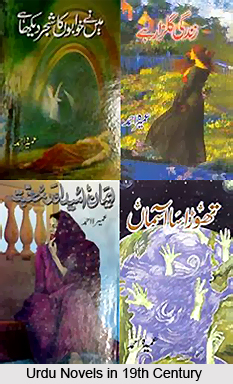 Urdu novels in 19th century comprised the major part of Urdu literature produced during this period. During this time, a large body of prose literature of all types was produced and eagerly consumed by the public. Ideas on reform were being gradually propagated and the idea of modernity in writing was gradually gaining ground. The layout of the novel was appropriated by Urdu writers in much their own way, serving their specific ideological, aesthetic or/and commercial purposes. It mainly drew from indigenous narrative traditions and from Western models according to the requirements of the text.
Urdu novels in 19th century comprised the major part of Urdu literature produced during this period. During this time, a large body of prose literature of all types was produced and eagerly consumed by the public. Ideas on reform were being gradually propagated and the idea of modernity in writing was gradually gaining ground. The layout of the novel was appropriated by Urdu writers in much their own way, serving their specific ideological, aesthetic or/and commercial purposes. It mainly drew from indigenous narrative traditions and from Western models according to the requirements of the text.
Remarks by several Urdu authors point to the fact that, initially, the novel was suspiciously regarded as a rather light-hearted or even obscene genre, not fit to be read by women and the young. In this regard, words were seen as having much in common with traditional tales. Similar characters are seen in the novels- more or less faithful lovers falling in love at first sight; lecherous and foolish old Nawabs and their sycophants; tricksters and criminals; loose women. What is new in the novels are advocates of modern education and the Western way of life, who are, however, often ridiculed. As a whole, the world of early popular novels is full of sexual lust, intrigue, deceit, adventure, surprising coincidences and reversals, and often attitudes that are utterly disrespectful of any higher moral values.
Thus, when advertising books sold at the Urdu Novel Depot in Nakhkhas, Lucknow, it was said: `In the Urdu Novel Depot you find all kinds of pure novels of good taste.` Two novels, in particular, by Munshi Ahmad Husain Khan are mentioned in the advertisement: Gulab Kaur and Gardish-iAyyam. The first is described as a story about the evil consequences of second marriage, the final victory of modesty and virtue, the wonders of love, etc., and the second as a story exposing the falseness of courtesans, the ruin of families, separations and happy reunions. Judging from the advertisement, these works presented a mixture of ideas of social reform (borrowed perhaps from Nazir Ahmad), melodramatic love stories including the conventional praise of female virtue and chastity and narrations of extra-marital sexual relations.
Gradually, there was a real explosion in the publication of novels as well as a remarkable establishment of the novel form. Novels became more realistic in setting and acquired their own style, distinct from traditional modes of narration. Even though much of the narrative tradition was kept in the process, it was modified. The themes of traditional narrative that survived, mainly in commercial novels, are seduction and adultery, male and female rogues, courtesans and burglars, and comic episodes involving slapstick comedy. However, changes were seen in the in the shift from visual and scenic presentations to narrations, and mimetic techniques. Narrative devices were now refined. In spite of the stereotyped settings and characters, detailed descriptions of localities, exact timing of the action, and attempts at individualising the lead characters were designed to create an authentic, `realistic` atmosphere. Among the vast number of novels that appeared and have since fallen into oblivion, there is a wide range from mere formulaic writing to fairly individualised works.



















